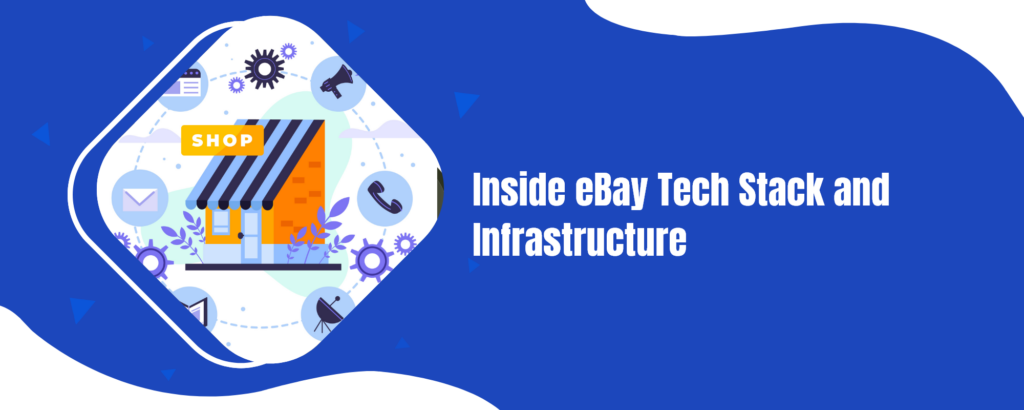eBay pushes over $74 billion in merchandise every year and serves more than 130 million active buyers. That kind of volume needs more than just clever logistics. It takes a tech stack that can handle massive scale, real-time bidding, global payments, and personalized recommendations without breaking a sweat.
If you’re building something in that space, understanding how eBay’s infrastructure works can help you skip a lot of trial and error. And while building a marketplace like eBay from scratch is no small task, platforms like Appscrip can give you a serious head start. With pre-built modules for real-time updates, payments, search, and more, you’re not starting from zero. Let’s take a closer look at how eBay tech stack keeps things running behind the scenes and what that means for anyone trying to build a marketplace today.
TL;DR
Frontend:
- React + Redux: For fast, dynamic user interfaces and centralized state management.
- JavaScript, HTML5, CSS3: Core web technologies for interactivity, structure, and styling.
Backend:
- Java & Node.js: Handle large-scale, high-performance backend operations.
- MongoDB & MySQL: Mix of NoSQL and relational databases for flexible data handling.
- Redis: Used for caching to boost speed.
Infrastructure & DevOps:
- Docker & Kubernetes: Containerization and orchestration for scalability and efficiency.
- Jenkins, Prometheus, Grafana: CI/CD and monitoring tools to keep systems running smoothly.
Cloud:
- OpenStack, Azure, GCP: Hybrid cloud setup for flexibility, performance, and global reach.
Frontend technologies of eBay Tech Stack
eBay utilizes a modern and robust frontend tech stack to deliver a seamless and user-friendly online marketplace experience to its millions of users. The primary frontend components of eBay tech stack include:
HTML5: As the backbone of the web, HTML5 is used by eBay to structure the content on its webpages. HTML5 offers various improvements over its predecessors, such as enhanced multimedia support, semantic tags, and better accessibility features, making it easier for eBay to create a rich and engaging user experience.
CSS3: Cascading Style Sheets (CSS) is responsible for styling and formatting the appearance of eBay’s webpages. With CSS3, eBay can create visually appealing designs, animations, and transitions, ensuring a consistent look and feel across the platform. CSS3’s advanced features, such as media queries and flexible box layouts, also enable eBay to optimize its site for various devices and screen sizes.
JavaScript: JavaScript is the primary scripting language employed by eBay tech stack to add interactivity and dynamic content to its webpages. By leveraging JavaScript, eBay can create responsive user interfaces, handle user inputs, and fetch data from the backend, all in real-time. eBay also uses various JavaScript libraries and frameworks, such as jQuery and React, to build reusable components and streamline the development process.

React: eBay has adopted React, a popular JavaScript library developed by Facebook, for building its user interface components. React’s component-based architecture and efficient rendering capabilities make it an ideal choice for managing eBay’s complex and data-driven UI. React also enables eBay to improve performance and maintainability by facilitating code reusability and modularization.
Redux: For state management, eBay uses Redux, a predictable state container for JavaScript apps. Redux allows eBay to manage the application state in a centralized store, making it easier to track changes, debug, and maintain the codebase. By integrating Redux with React, eBay can efficiently manage the flow of data across its various components and ensure a consistent user experience.
Webpack: eBay tech stack employs Webpack, a popular module bundler, to optimize and bundle its JavaScript, CSS, and other assets. Webpack helps eBay to manage dependencies, improve page load times, and streamline the development workflow by automating various tasks, such as minification and code splitting.
Node.js and Express: To power its server-side rendering and APIs, eBay utilizes Node.js, a JavaScript runtime built on Chrome’s V8 engine. eBay also leverages Express, a minimalistic web framework for Node.js, to build its server-side infrastructure, enabling faster page loads and improved SEO.
Read more: What Is A Marketplace Business Model?
Backend technologies of eBay Tech Stack
eBay relies on a robust backend technology stack to ensure seamless performance, scalability, and security. Here’s an overview of some key components of eBay’s backend technology stack:
Programming Languages: eBay primarily uses Java for its backend services. Java is a popular choice for e-commerce platforms due to its platform independence, scalability, and extensive libraries for building robust applications. JavaScript (Node.js) and Python are also used in some parts of the system.
Web Frameworks: eBay uses Spring Boot, a Java-based framework, for building microservices. Spring Boot simplifies the development of stand-alone, production-grade applications by providing an opinionated approach to configuration and offering embedded server options. This allows eBay to focus on building features rather than dealing with infrastructure complexities.
Databases: eBay employs a mix of relational and NoSQL databases to cater to different storage and retrieval requirements. Oracle is the primary relational database management system used for transactional data. For handling large-scale data, eBay leverages Apache Cassandra, a highly scalable and distributed NoSQL database that offers high availability and fault tolerance.
Big Data & Analytics: eBay tech stack processes massive amounts of data daily, requiring powerful big data and analytics tools. The company uses Apache Kafka for real-time data streaming and Apache Spark for big data processing and analytics. These tools help eBay analyze user behavior, optimize the platform, and provide personalized recommendations to users.
Search Technologies: eBay’s search functionality is powered by Apache Solr, an open-source search platform built on Apache Lucene. Solr offers advanced search capabilities, such as faceted search, filtering, and distributed searching, which are crucial for an e-commerce platform like eBay.
Caching: To enhance performance and reduce database load, eBay employs caching mechanisms like Memcached and Redis. These in-memory data storage systems speed up data retrieval by temporarily storing frequently accessed data in memory rather than fetching it from the database every time.
Containerization & Orchestration: eBay tech stack uses Docker for containerization, which enables developers to package applications and their dependencies into containers, ensuring consistency and portability across environments. Kubernetes, an open-source container orchestration platform, is employed to manage, scale, and deploy these containers automatically.
Cloud Services: eBay leverages public cloud services, such as Amazon Web Services (AWS) and Google Cloud Platform (GCP), to host and manage its infrastructure. These cloud providers offer a wide range of services, from compute and storage to machine learning and analytics, which enable eBay to scale its operations efficiently.
CI/CD & DevOps: Continuous Integration and Continuous Deployment (CI/CD) are essential for eBay’s fast-paced development environment. Tools like Jenkins and GitLab CI help automate the build, testing, and deployment processes, ensuring that code changes are seamlessly integrated and deployed to production.
Monitoring & Logging: To maintain high availability and performance, eBay tech stack uses monitoring and logging tools like Prometheus and Grafana for infrastructure monitoring, and Elasticsearch, Logstash, and Kibana (ELK Stack) for log aggregation and analysis.

Infrastructure technologies of eBay Tech Stack
OpenStack Private Cloud: eBay runs its website and mission-critical customer-facing applications on an OpenStack private cloud platform developed in-house. OpenStack, an open-source cloud computing platform, allows eBay to maintain control over its infrastructure while benefiting from the scalability, flexibility, and cost-effectiveness of cloud computing.
Microsoft Azure Platform Appliance: eBay is one of the first customers of Microsoft Azure platform appliance for cloud computing. This partnership enables eBay to efficiently manage its capacity and resources through an automated, scalable, and cost-effective solution. Azure provides eBay with the tools to develop, deploy, and manage applications in the cloud, streamlining their processes and improving overall performance.
Google Cloud Platform: eBay has successfully transitioned to Google’s cloud platform, which allows it to run mission-critical workloads in the cloud. Google Cloud Platform provides a suite of services, including storage, compute, and machine learning, which enable eBay to leverage advanced analytics and image recognition capabilities for better user experience.
X.commerce Platform: Built on OpenStack cloud architecture, eBay’s X.commerce platform serves as a flexible, scalable, and customizable e-commerce solution that supports eBay’s Marketplace and other online business initiatives.
Asset Transparency and Capacity Management: Utilizing cloud computing, eBay’s IT team benefits from sophisticated capacity management capabilities and asset transparency. This enables them to monitor and optimize resource allocation, ensuring efficient utilization of infrastructure and providing a seamless experience for users.
Self-service Flexibility: Cloud infrastructure enables eBay tech stack to benefit from self-service flexibility, streamlining software and application development and deployment processes. This has reduced app-provisioning time from four weeks to just 30 minutes and rack onboarding time from 45 days to three days.
Read more: Social Commerce vs Ecommerce- Alternative Online Shopping
How Appscrip Can Help
Building a platform like eBay from scratch takes forever. Between the frontend, backend, real-time features, and scaling concerns, it’s a massive project.
That’s where Appscrip saves the day.
We’ve built a ready-to-launch marketplace platform using the same kind of tech eBay runs on — React, Node.js, Redis, Kubernetes. It’s fast, flexible, and fully customizable to fit your brand and business model.
Here’s what you get:
- Scalable Backend: Handles traffic, listings, and transactions with ease
- Customizable UI: Built with React so you can make it your own
- Blazing Fast Search: Thanks to Elasticsearch
- Built-in Payments: Secure and ready to go
- Real-Time Features: Orders, chats, bids — all live
- Seller & Auction Tools: Multi-vendor support, commission settings, and auction logic baked in
If you’re serious about building a marketplace and want to launch fast without compromising on quality, Appscrip is built for you. No fluff. Just solid tech that works. We can have a chat to get to know your marketplace app idea!





